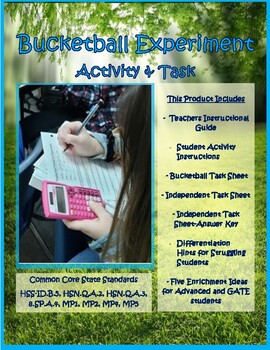- PDF
Description
The Bucketball Experiment Activity & Task gives students an opportunity to practice gathering random data, organizing that data into a table, and then determining the relative frequency of the data in a context that is fun and personal. This activity/task has two parts. First students participate in the Bucketball Experiment Activity and record their raw data. Once that is completed and shared between teams, students will partner up to complete the second part, Bucketball Experiment Task. This task asks students to complete a two-way frequency table and then use the results to find solutions.
Students will:
1. Participate in the Bucketball Experiment Activity.
2. Record random data in real time.
3. Organize data into a two-way frequency table.
4. Determine the relative frequency of the collected data.
5. Apply the frequency data to find real solutions.
The Bucketball Experiment Activity & Task is a great activity for the middle of a unit on statistics & probability. Students need to know how to find percentage rates from a fraction before beginning this task. I have students use a calculator to keep the focus on probability and statistics concepts rather than long division. The activity and task take 60 to 90 minutes to complete depending on the mathematical level of the students. Students with average or advanced mathematical skills will complete this task in 60 minutes. Struggling students and English Language Learners may need 90 minutes. This product focuses on Common Core Math Standards: HSS.ID.B.5, HSN.Q.A.2, HSN.Q.A.3, 8.SP.A.4, MP1, MP2, MP4, and MP5.
**************************************************************************************************
Customer Tips: How to get TPT credit for future purchases:
Go to your “My Purchases” page. Next to each purchase, you'll see a “Provide Feedback” button. Simply click it and you will be taken to a page where you can give a quick rating and leave a short comment for the product. Each time you give feedback, TPT gives you feedback credits that you may use to lower the cost of your future purchases. We'd really love it if you'd rate our item after downloading! Feedback is so VERY important!
**************************************************************************************************
Follow my Store
Click on the green star next to my store logo to receive upcoming sales, freebie and product launches, and email updates!
Here's to a successful year!
Absolute Value
Petty415@gmail.com
For more Project Based Learning with Mathematics available at my store: https://www.teacherspayteachers.com/Store/Absolute-Value. This project was created and provided by Absolute Value.





